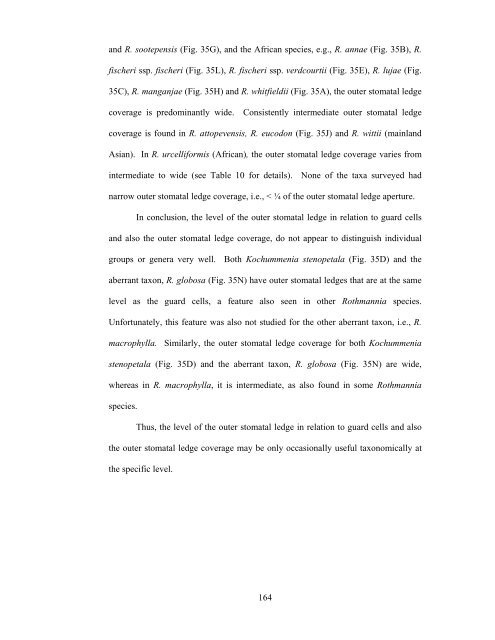Chapter 5.pdf - DSpace@UM
Chapter 5.pdf - DSpace@UM
Chapter 5.pdf - DSpace@UM
You also want an ePaper? Increase the reach of your titles
YUMPU automatically turns print PDFs into web optimized ePapers that Google loves.
and R. sootepensis (Fig. 35G), and the African species, e.g., R. annae (Fig. 35B), R.fischeri ssp. fischeri (Fig. 35L), R. fischeri ssp. verdcourtii (Fig. 35E), R. lujae (Fig.35C), R. manganjae (Fig. 35H) and R. whitfieldii (Fig. 35A), the outer stomatal ledgecoverage is predominantly wide. Consistently intermediate outer stomatal ledgecoverage is found in R. attopevensis, R. eucodon (Fig. 35J) and R. wittii (mainlandAsian). In R. urcelliformis (African), the outer stomatal ledge coverage varies fromintermediate to wide (see Table 10 for details). None of the taxa surveyed hadnarrow outer stomatal ledge coverage, i.e., < ¼ of the outer stomatal ledge aperture.In conclusion, the level of the outer stomatal ledge in relation to guard cellsand also the outer stomatal ledge coverage, do not appear to distinguish individualgroups or genera very well. Both Kochummenia stenopetala (Fig. 35D) and theaberrant taxon, R. globosa (Fig. 35N) have outer stomatal ledges that are at the samelevel as the guard cells, a feature also seen in other Rothmannia species.Unfortunately, this feature was also not studied for the other aberrant taxon, i.e., R.macrophylla. Similarly, the outer stomatal ledge coverage for both Kochummeniastenopetala (Fig. 35D) and the aberrant taxon, R. globosa (Fig. 35N) are wide,whereas in R. macrophylla, it is intermediate, as also found in some Rothmanniaspecies.Thus, the level of the outer stomatal ledge in relation to guard cells and alsothe outer stomatal ledge coverage may be only occasionally useful taxonomically atthe specific level.164
















